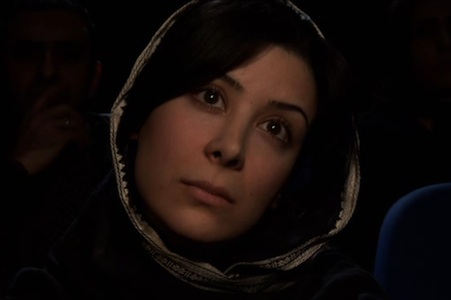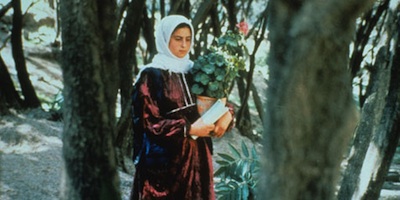
“Their arrows were not as piercing as your gaze,” a warrior says, comparing his battlefield rivals to his lover, in Abbas Kiarostami’s 2008 film Shirin. The characters’ gazes have always pierced in Kiarostami’s films, shooting offscreen in search of an absent object of desire. This is true for all three members of the central love triangle in Like Someone in Love (2012), Kiarostami’s most recent feature film, which begins its New York theatrical run February 15 after premiering at Cannes last year. In it, a young woman, her boyfriend and an old man requesting her company all spend time alone within frames, looking outwards. Each looks out a window of his or her private world.The register of a world within a human face has been a part of the Iranian master’s films since he began making them as an ongoing career retrospective at Lincoln Center, running through February 17 as accompaniment to Like Someone in Love’s run, shows. In Kiarostami’s first film, The Bread and Alley (1970), a young boy’s delight in and fear of the world around him compete inside his terrified eyes; the subsequent Breaktime (1972) looks outwards, towards something deeper and stranger, as another boy’s searching expression leads him away from his school down unknown paths.Kiarostami continued capturing looks in the series of children’s educational films he made for the Institute for Intellectual Development of Children and Young Adults (Kanun), then into the subsequent films he made about childlike adults. Hossein Sabzian’s desire for others to recognize him as a film star turns into pleading for attention within what the director Kiarostami gives him in Close-Up (1990). As Sabzian professes to be honestly apologizing for past deceptions, he is simultaneously acting and being. The young man at the center of Through the Olive Trees (1994), starring in a film-within-a-film shot in his rural hometown, does this even more literally. The actor plays at being in love with his silent, distant co-star; the man follows the woman along a winding path, describing details of the life he imagines them spending together with a passion more immediate than anything else that passes between them.The driving characters of Kiarostami’s films—dreamers whose faces are turned away from daily life in search of ideals—have consistently been men. In the films where he has granted prominent isolated, idealizing gazes to members of both genders (such as Like Someone in Love, as well as The Report [1977], 10 [2002], and Certified Copy [2010]), the duality has suggested the imagined ideal of love as a meeting point that can, at best, briefly bridge two divergent paths. The feature Shirin (which, in addition to screening at Lincoln Center on February 16, is available for streaming here) and its earlier three-minute companion film Where Is my Romeo? (made for the Cannes-commissioned omnibus film To Each his own Cinema [2007]), both edited from the same footage, are two films that he has made with a strong focus on the dream lives of women. Yet while the gender shift might initially seem like a great change in Kiarostami’s art, what it actually goes on to prove is that, for this artist, a dreamer’s gender doesn’t matter much. Especially when it comes to love, dreaming holds a universal appeal.

Both Where Is my Romeo? and Shirin consist almost entirely of individual close-ups of women in a movie theater, with a few other people (both women and men) sometimes glimpsed seated behind them. The group is watching a film adaptation of a well-known tragic love story, whose soundtrack we hear while its audience members seemingly react. The responses to Franco Zeffirelli’s film adaptation of Romeo & Juliet (1968) also fit a new cinematic retelling of the Iranian epic poem Khosrow and Shirin (by Hakim Nezami Ganjavi, adapted into the prose basis for M. Rahmanian’s screenplay by Farrideh Golbou). Juliet’s solitary call of “Come, gentle night, and bring me my Romeo” is echoed in how the princess Shirin, separated from her beloved while he fights a battle, tells the river in which she bathes to “Caress me with your droplets, hold me like a lover, take my breath away.” In both the Shakespeare play and the Persian poem, a woman’s desire for her absent lover wills him into being.This is also essentially what is happening throughout both of Kiarostami’s films, and in particular Shirin, which begins with a dissolving succession of illustrated images depicting the stages of a classic love story: A daring rescue, a marriage, a flight from enemies, a mutual death. The film the women in the onscreen audience are watching subsequently begins. Shirin ends when this film does, and until then turns their spectatorship into our spectacle. The brief appearance of a burka-wearing Juliette Binoche (first laughing, later crying) as an audience member throws into relief the offscreen identity of professional performer that (with two or three exceptions) most of the other more than one hundred women whose faces we see throughout Shirin share. (Save for Leila Hatami, the lead actress of A Separation [2011], most of these Iranian stage and film actresses are likely to be previously unknown to Shirin‘s Western public.) Kiarostami’s film asserts the stardom of these women through the kind of shot that typically designates a star from extras: The close-up. An old woman, wrinkles rippling throughout her cheeks, smiles peacefully at the prospect of a lover’s reunion; a younger woman, holding her breath, stares concerned into the sight of love endangered.A close-up brings a viewer closer to an actor, usually encouraging identification. We see how the character is feeling, and take how we should feel from him or her cues. “You are actually watching yourselves,” Kiarostami told his actresses when they filmed Shirin on empty chairs set up in his living room (a process registered in Hamideh Razavi’s 2008 film Taste of Shirin, available as an extra on Shirin’s Cinema Guild DVD). “You, as spectators, are now watching yourselves as actresses.”They are not the only performers regarding themselves in Shirin. a story is meaningful to its recipient, the person will likely imagine himself or herself either inside it or in direct communication with it. The imagination leads one to absorb and participate in a story at the same time. Shirin has a chorus of female companions who do this, drawing close to her as she addresses them: “Listen to me, my sisters. It is my turn to recount my story, recount it to you.” She subsequently conducts them to provide accompaniment for her emotions. One Shirin audience member after another breathes heavily as women weep and wail upon Shirin’s command. While at first we might think that we will not see Shirin’s female attendants, the women in the audience we are watching soon become them.And we, in the audience watching them watch a film are also being emotionally conducted. Kiarostami filmed his actresses’ faces while they were looking at sheets of paper, created the soundtrack of the film-within-a-film separately, and then fit images and sounds together. He told the actresses that, for the five to six minutes he filmed them, they should imagine their own personal love stories. “I didn’t mean a movie,” he tells Iranian film critic Nima Hassani-Nasab in an interview translated by Ehsan Khoshbakht for Keyframe. “I meant a situation, or a memory, in real life.” Any moment in the resulting film Shirin contains at least three films: The one playing in front of the onscreen audience member, the one that she is creating for herself, and the one that the offscreen audience member creates by placing the two together. As all these films are projected, we viewers project ourselves onto them.Everyone who can imagine is capable of starring in a movie, even if it’s just a movie of a mind. This is especially true with a love story (the same words are used in English and in Persian), as love is a concept general enough to be understood by many people while still carrying a different, specific, immediately perceivable sensation for each one. When I recently interviewed Kiarostami for the webzine Idiom about his latest feature film, he told me that its title appealed to him because he believed it could be applied to anyone, whether currently in love or not, as they wonder what the period of loving has been and could be like. He told me, “This happens even with the classic love affairs that we experience in literature, or that we have in real life.”One often loves with a heightened awareness of time, Kiarostami’s films suggest; by presenting a love affair within a structural framework (love lasting as long as a love story), Shirin makes this point explicitly. Love may relax one into forgetting time, but as time passes each moment between lovers may seem more precious. Once it becomes clear that more time will be spent without a beloved than with him or her, sadness may creep into lovers’ meetings. The very fact that each meeting begins promises that it will end. A permanent separation between lovers will eventually arrive. Love stories, whether epic or everyday, will always end sadly. Khosrow tells Shirin that she has turned his nightmare into a sweet dream, but however sweet that dream is, both lovers know he will eventually wake up.Love is sweetly bitter, offering comfort while promising absence. Yet even though loving someone means that a lover will be alone for most of the time, without love he or she would be alone entirely. After Khosrow’s death Shirin tells all her weeping women, both onscreen and offscreen, “You look at his dead body and you cry. You listen to my story and you cry. Through these tears, I see your eyes.” She offers solace through recognition. Shirin, like her audience, has loved, and knows how good it can feel.



